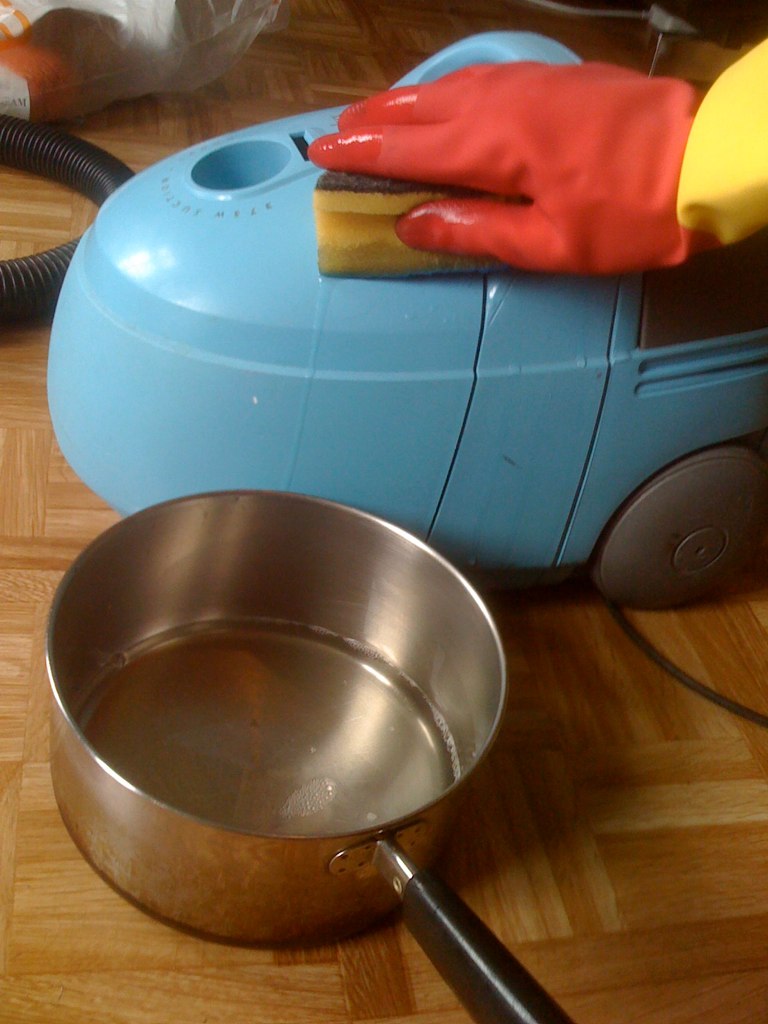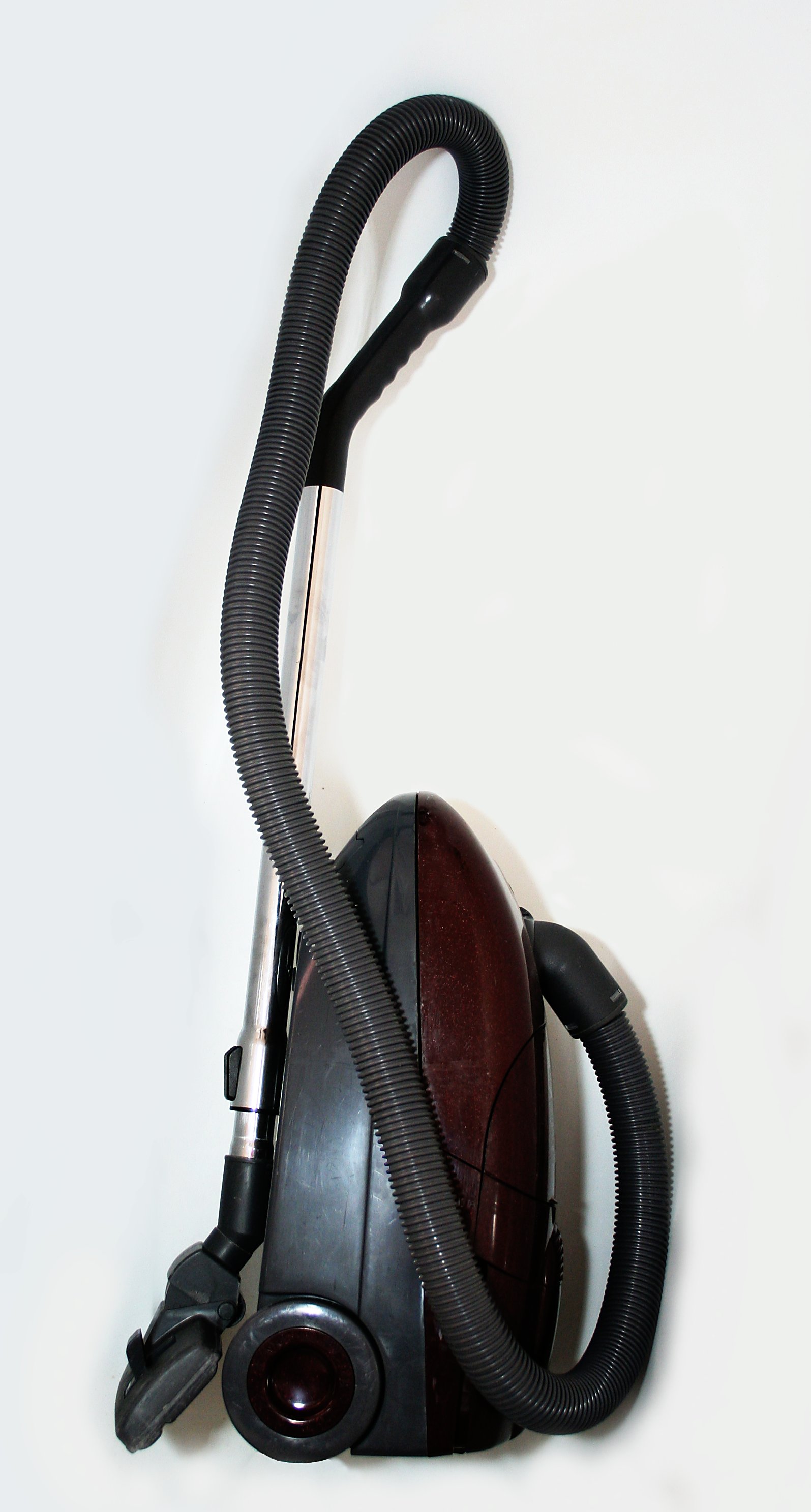|
Spray-and-vac Cleaning
Spray-and-vac cleaning is a “no-touch” method – cleaning is accomplished without the need for workers to touch soiled surfaces with their hands – used in professional cleaning in which a pressurized, diluted cleaning solution is applied to soiled or contaminated surfaces. Description To start, a diluted cleaning solution (white vinegar, bleach and detergent) is sprayed onto all surfaces to be cleaned, Using the same machine, the area is then rinsed; this is typically followed by vacuum suctioning that removes the applied liquid along with the suspended solids and dissolved contaminants that have been removed from the surface. A key advantage of this method over traditional approaches is the ability to deep clean grouted areas (e.g. wall, counter and floor tile) preventing buildup of soil and bacteria in grout lines. Application of a cleaning solution followed by pressurized rinsing and vacuuming removes soil more effectively than methods that rely solely on absorbent wip ... [...More Info...] [...Related Items...] OR: [Wikipedia] [Google] [Baidu] |
Cleaning
Cleaning is the process of removing unwanted substances, such as dirt, infectious agents, and other impurities, from an object or environment. Cleaning is often performed for aesthetic, hygienic, functional, environmental, or safety purposes. Cleaning occurs in many different contexts, and uses many different methods. Several occupations are devoted to cleaning. Contexts Cleaning occurs in various commercial, domestic, personal, and environmental contexts, which differ in scale and requirements. * Commercial cleaning, in business or other commercial settings ** Terminal cleaning, in healthcare settings * Environmental remediation, the removal of pollution or contaminants from the natural environment * Housekeeping, including spring cleaning * Hygiene, including personal grooming Methods Cleaning is broadly achieved through mechanical action and/or solvent action; many methods rely on both processes. * Washing, usually done with water and often some kind of soap or detergent ... [...More Info...] [...Related Items...] OR: [Wikipedia] [Google] [Baidu] |
Pressurized
{{Wiktionary Pressurization or pressurisation is the application of pressure in a given situation or environment. Industrial Industrial equipment is often maintained at pressures above or below atmospheric. Atmospheric This is the process by which atmospheric pressure is maintained in an isolated or semi-isolated atmospheric environment (for instance, in an aircraft, or whilst scuba diving). See also * Cabin pressurization * Compressed air * Decompression (diving) * Decompression (physics) * Gas compressor * :Units of pressure * Pressurisation ductwork Pressurisation duct work is a passive fire protection system. It is used to supply fresh air to any area of refuge, designated emergency evacuation or egress route. Purpose The purpose of pressurisation ductwork is to maintain positive pressure ... Pressure it:Pressurizzazione (aeronautica) ... [...More Info...] [...Related Items...] OR: [Wikipedia] [Google] [Baidu] |
Cleaning Agent
Cleaning agents or hard-surface cleaners are substances (usually liquids, powders, sprays, or granules) used to remove dirt, including dust, stains, bad smells, and clutter on surfaces. Purposes of cleaning agents include health, beauty, removing offensive odor, and avoiding the spread of dirt and contaminants to oneself and others. Some cleaning agents can kill bacteria (e.g. door handle bacteria, as well as bacteria on worktops and other metallic surfaces) and clean at the same time. Others, called degreasers, contain organic solvents to help dissolve oils and fats. Chemical agents Acidic Acidic cleaning agents are mainly used for removal of inorganic deposits like scaling. The active ingredients are normally strong mineral acids and chelants. Often, surfactants and corrosion inhibitors are added to the acid. Hydrochloric acid is a common mineral acid typically used for concrete. Vinegar can also be used to clean hard surfaces and remove calcium deposits that also helps t ... [...More Info...] [...Related Items...] OR: [Wikipedia] [Google] [Baidu] |
Vacuum Cleaner
A vacuum cleaner, also known simply as a vacuum or a hoover, is a device that causes suction in order to remove dirt from floors, upholstery, draperies, and other surfaces. It is generally electrically driven. The dirt is collected by either a dustbag or a cyclone for later disposal. Vacuum cleaners, which are used in homes as well as in industry, exist in a variety of sizes and models—small battery-powered hand-held devices, wheeled canister models for home use, domestic central vacuum cleaners, huge stationary industrial appliances that can handle several hundred litres of dirt before being emptied, and self-propelled vacuum trucks for recovery of large spills or removal of contaminated soil. Specialized shop vacuums can be used to suck up both solid matter and liquids. Name Although ''vacuum cleaner'' and the short form ''vacuum'' are neutral names, in some countries (UK, Ireland) ''hoover'' is used instead as a genericized trademark, and as a verb. The name comes from t ... [...More Info...] [...Related Items...] OR: [Wikipedia] [Google] [Baidu] |
Microfiber
Microfiber (or microfibre) is synthetic fiber finer than one denier or decitex/thread, having a diameter of less than ten micrometers. A strand of silk is about one denier and about a fifth of the diameter of a human hair. The most common types of microfiber are made variously of polyesters; polyamides (e.g., nylon, Kevlar, Nomex); and combinations of polyester, polyamide, and polypropylene. Microfiber is used to make mats, knits, and weaves, for apparel, upholstery, industrial filters, and cleaning products. The shape, size, and combinations of synthetic fibers are chosen for specific characteristics, including softness, toughness, absorption, water repellence, electrostatics, and filtering ability. History Production of ultra-fine fibers (finer than 0.7 denier) dates to the late 1950s, using melt-blown spinning and flash spinning techniques. Initially, only fine staples of random length could be manufactured and very few applications were found. Then came experiments to p ... [...More Info...] [...Related Items...] OR: [Wikipedia] [Google] [Baidu] |
International Sanitary Supply Association
International is an adjective (also used as a noun) meaning "between nations". International may also refer to: Music Albums * ''International'' (Kevin Michael album), 2011 * ''International'' (New Order album), 2002 * ''International'' (The Three Degrees album), 1975 *''International'', 2018 album by L'Algérino Songs * The Internationale, the left-wing anthem * "International" (Chase & Status song), 2014 * "International", by Adventures in Stereo from ''Monomania'', 2000 * "International", by Brass Construction from ''Renegades'', 1984 * "International", by Thomas Leer from ''The Scale of Ten'', 1985 * "International", by Kevin Michael from ''International'' (Kevin Michael album), 2011 * "International", by McGuinness Flint from ''McGuinness Flint'', 1970 * "International", by Orchestral Manoeuvres in the Dark from '' Dazzle Ships'', 1983 * "International (Serious)", by Estelle from '' All of Me'', 2012 Politics * Political international, any transnational organization of ... [...More Info...] [...Related Items...] OR: [Wikipedia] [Google] [Baidu] |
Orders Of Magnitude (pressure) ...
This is a tabulated listing of the orders of magnitude in relation to pressure expressed in pascals. References {{Orders of magnitude Units of pressure Pressure Pressure (symbol: ''p'' or ''P'') is the force applied perpendicular to the surface of an object per unit area over which that force is distributed. Gauge pressure (also spelled ''gage'' pressure)The preferred spelling varies by country and e ... [...More Info...] [...Related Items...] OR: [Wikipedia] [Google] [Baidu] |
Cleaning Industry
Cleaning is the process of removing unwanted substances, such as dirt, infectious agents, and other impurities, from an object or environment. Cleaning is often performed for aesthetic, hygienic, functional, environmental, or safety purposes. Cleaning occurs in many different contexts, and uses many different methods. Several occupations are devoted to cleaning. Contexts Cleaning occurs in various commercial, domestic, personal, and environmental contexts, which differ in scale and requirements. * Commercial cleaning, in business or other commercial settings ** Terminal cleaning, in healthcare settings * Environmental remediation, the removal of pollution or contaminants from the natural environment * Housekeeping, including spring cleaning * Hygiene, including personal grooming Methods Cleaning is broadly achieved through mechanical action and/or solvent action; many methods rely on both processes. * Washing, usually done with water and often some kind of soap or detergent ... [...More Info...] [...Related Items...] OR: [Wikipedia] [Google] [Baidu] |
Public Toilet
A public toilet, restroom, public bathroom or washroom is a room or small building with toilets (or urinals) and sinks for use by the general public. The facilities are available to customers, travelers, employees of a business, school pupils and prisoners and are commonly sex segregation, separated into male and female toilets, although unisex toilet, some are unisex, especially for small or single-occupancy public toilets. Increasingly, accessible toilet, public toilets are accessible to people with disabilities. Depending on the culture, there may be varying degrees of separation between males and females and different levels of privacy. Typically, the entire room, or a stall or cubicle containing a toilet, is lockable. Urinals, if present in a male toilet, are typically mounted on a wall with or without a divider between them. local authority, Local authorities or commercial businesses may provide public toilet facilities. Some are unattended while others are staffed by an ... [...More Info...] [...Related Items...] OR: [Wikipedia] [Google] [Baidu] |
Cafeteria
A cafeteria, sometimes called a canteen outside the U.S., is a type of food service location in which there is little or no waiting staff table service, whether a restaurant or within an institution such as a large office building or school; a school dining location is also referred to as a dining hall or lunchroom (in American English). Cafeterias are different from coffeehouses, although the English term came from the Spanish ''cafetería'', same meaning. Instead of table service, there are food-serving counters/stalls or booths, either in a line or allowing arbitrary walking paths. Customers take the food that they desire as they walk along, placing it on a tray. In addition, there are often stations where customers order food, particularly items such as hamburgers or tacos which must be served hot and can be immediately prepared with little waiting. Alternatively, the patron is given a number and the item is brought to their table. For some food items and drinks, such a ... [...More Info...] [...Related Items...] OR: [Wikipedia] [Google] [Baidu] |
Adenosine Triphosphate
Adenosine triphosphate (ATP) is an organic compound that provides energy to drive many processes in living cells, such as muscle contraction, nerve impulse propagation, condensate dissolution, and chemical synthesis. Found in all known forms of life, ATP is often referred to as the "molecular unit of currency" of intracellular energy transfer. When consumed in metabolic processes, it converts either to adenosine diphosphate (ADP) or to adenosine monophosphate (AMP). Other processes regenerate ATP. The human body recycles its own body weight equivalent in ATP each day. It is also a precursor to DNA and RNA, and is used as a coenzyme. From the perspective of biochemistry, ATP is classified as a nucleoside triphosphate, which indicates that it consists of three components: a nitrogenous base (adenine), the sugar ribose, and the Polyphosphate, triphosphate. Structure ATP consists of an adenine attached by the 9-nitrogen atom to the 1′ carbon atom of a sugar (ribose), which i ... [...More Info...] [...Related Items...] OR: [Wikipedia] [Google] [Baidu] |
Bioluminescence
Bioluminescence is the production and emission of light by living organisms. It is a form of chemiluminescence. Bioluminescence occurs widely in marine vertebrates and invertebrates, as well as in some fungi, microorganisms including some bioluminescent bacteria, and terrestrial arthropods such as fireflies. In some animals, the light is bacteriogenic, produced by symbiotic bacteria such as those from the genus ''Vibrio''; in others, it is autogenic, produced by the animals themselves. In a general sense, the principal chemical reaction in bioluminescence involves a light-emitting molecule and an enzyme, generally called luciferin and luciferase, respectively. Because these are generic names, luciferins and luciferases are often distinguished by the species or group, e.g. firefly luciferin. In all characterized cases, the enzyme catalyzes the oxidation of the luciferin. In some species, the luciferase requires other cofactors, such as calcium or magnesium ions, and somet ... [...More Info...] [...Related Items...] OR: [Wikipedia] [Google] [Baidu] |



